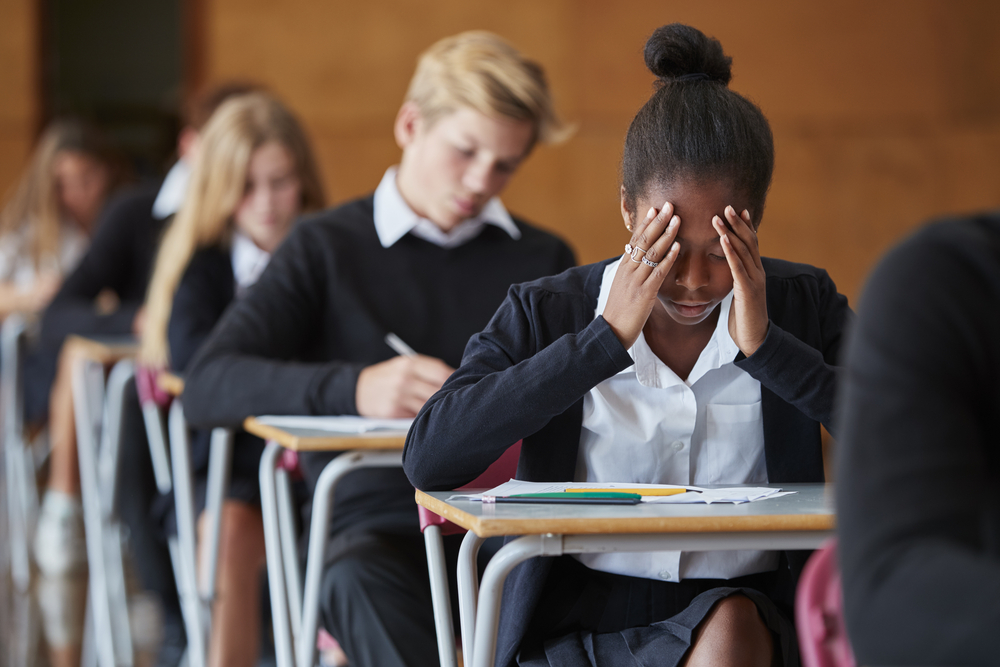In a recent article published in the BJPsych Bulletin, researchers argue that school mental health interventions may inadvertently harm some adolescents. As the United Kingdom aims to implement mental health programs more broadly in schools, the authors caution that a national rollout could exacerbate these adverse effects. They also provide possible explanations for why these programs, intended to alleviate distress, might sometimes worsen it.
The authors, Lucy Foulkes and Argyris Stringaris, from the University of Oxford, UK, write:
“A growing body of quantitative research indicates that some aspects of school-based mental health interventions increase distress or clinical symptoms, relative to control activities, and qualitative work indicates that this may be partly due to the interventions themselves.”
 The article’s primary objective is to present evidence that school-wide mental health interventions can harm some adolescents. To achieve this, the authors review previous research on the negative effects of these interventions and propose potential mechanisms for the harm they may cause.
The article’s primary objective is to present evidence that school-wide mental health interventions can harm some adolescents. To achieve this, the authors review previous research on the negative effects of these interventions and propose potential mechanisms for the harm they may cause.
The authors identify one major issue with school-based mental health interventions: their universal application to all students. Such generalized interventions can impart irrelevant, unhelpful, or even harmful information while consuming valuable time and resources that could be better spent on more effective strategies for reducing distress.
A meta-analysis of school-based anti-bullying interventions revealed that some students who participated in cognitive behavioral therapy (CBT) experienced increased distress compared to those who did not receive the intervention. In addition, a randomized control trial also found that some students who had undergone CBT reported increased symptoms of distress.
The article also cites research on a school-based mindfulness program. While the intervention did not change depressive symptoms on average, students with higher rates of mental health symptoms experienced a slight increase. The authors argue that, as with this particular mindfulness-based program, the harm of other school-based mental health interventions may be concealed by average results.
The authors note that these findings align with research on mental health interventions (and public health interventions) in general, where a minority of people experience harm.
Though limited research has been conducted on how these school-based mental health interventions cause harm, the authors suggest possible mechanisms. For instance, the interventions might cause some adolescents to ruminate on their distress, thereby exacerbating it. In addition, encouraging adolescents to label their negative emotions with psychological terms (such as “anxiety”) could alter their self-image (thinking “I am someone with anxiety”) and behavior (avoiding situations that induce “anxiety”).
Peer influence is another potential factor in the harm caused by school-based mental health interventions. Since adolescents are highly susceptible to peer influence, discussing distress in group settings could lead to increased distress in others.
The authors express concern that implementing these school-based interventions nationwide could amplify their negative effects. Even if these programs are merely ineffective rather than harmful, they still monopolize resources that could be allocated to more beneficial practices, such as additional sleep, physical exercise, and socializing time. The authors conclude:
“There is currently a pervasive assumption that school-based mental health interventions are beneficial for all adolescents. The possibility that some individuals may deteriorate or experience harm as a result of such efforts has been almost entirely neglected. As a matter of urgency, research should begin that explores and documents what intervention harms might look like in school settings and which adolescents are most at risk. In time, all studies assessing school-based mental health interventions should measure and report cases of symptom deterioration and other adverse effects as standard, as happens with clinical trials. More importantly, it should become standard to have a plan of what to do with adolescents who deteriorate during these interventions.”
There is research that demonstrates that certain types of school-based mental health initiatives can yield positive results. For instance, one study revealed that bystander training aimed at preventing bullying enhanced student mental health. Similarly, another study indicated that school-based programs targeting anxiety and depression contributed to a decrease in symptoms. Likewise, a study on a school-based mindfulness program reported reduced stress levels. However, consistent with the current work, research has also discovered that universal interventions in schools frequently fall short and may result in detrimental outcomes.
The field of psychiatry has long been familiar with allegations of iatrogenic illness, a phenomenon in which treatment provided by practitioners leads to illness instead of relief. The now-debunked chemical imbalance theory, still endorsed by some mental health professionals, has the potential to cause iatrogenic harm by persuading individuals that they require medication to rectify non-existent chemical imbalances. Psychotropic drugs can bring numerous adverse effects, including the onset of psychiatric symptoms. Several practitioners contend that mental health disciplines should emphasize addressing and preventing iatrogenic harm.
****
Foulkes, L., & Stringaris, A. (2023). Do no harm: Can school mental health interventions cause iatrogenic harm? BJPsych Bulletin, 1–3. https://doi.org/10.1192/bjb.2023.9 (Link)















Additional educational mandates compete with time for choices that students experience as beneficial. Create opportunities for students to discover their talents and to learn holistic health habits while respecting their privacy.
Report comment
I agree. Privacy is the most important thing. And schools shouldn’t be teaching kids how to identify with “psychiatric disorders”.
Report comment
I think most adolescents are too young and suggestible to have enough perspective on something as ambiguous as “mental health”, i.e. “anxiety” or “depression”. A less heavy-handed approach that doesn’t emphasize “disorder” might help students feel less unnecessarily self-conscious.
Report comment
We like to imply that all “mental health” workers have “good intentions.” But I know from personal experience that sometimes school social workers have as a goal, covering up the flaws in their school system, as their goal. Since I had the misfortune of dealing with such a pathological lying social worker.
Thankfully, the school principal did finally confess to me that her school system was “not equipped to deal with the brightest children.” So I was able to protect my child from the crazy school social worker, by agreeing to send my child to a private school for high school.
But this is a big problem, when it comes to psychologists, et al, who are “partnered” with many large corporations, including the non-profits. I know the first university I graduated from sicked a disingenuous “counsellor” on me, to convince me to be a business major, instead of going into the field of architecture, which is the school I’d been accepted into, and the field I actually wanted to study.
I also now know my former religion is “partnered” with the “mental health” industries, and the “mental health” workers function as child abuse cover uppers for my former religion … whose bishops are now nothing more than systemic child abuse cover uppers.
https://books.google.com/books?id=xI01AlxH1uAC&printsec=frontcover&source=gbs_ge_
summary_r&cad=0#v=onepage&q&f=false
IMHO, ethics committees within the psychological field should do some ethics reeducation of their own, by making it clear that psychologists, et al should have zero right to take payment from anyone to “help” them … when in reality they are secretly “partnered” with, say, a religion.
The school social workers / psychologists work for the school, not the children. And as a psychopharmacological researcher who has found the medical proof of the iatrogenic etiology of the “sacred symbol of psychiatry.”
https://en.wikipedia.org/wiki/Toxidrome
https://en.wikipedia.org/wiki/Neuroleptic-induced_deficit_syndrome
And, of course, we here all know the ADHD drugs and antidepressants can create the “bipolar” symptoms.
https://www.amazon.com/Anatomy-Epidemic-Bullets-Psychiatric-Astonishing-ebook/dp/B0036S4EGE
I could not agree more “that [the] mental health disciplines should emphasize addressing and preventing iatrogenic harm,” as opposed to encouraging – and literally forcing it upon – innocent others … especially our children.
Honestly, I believe the psych “professionals” and social workers should be taken out of the schools, LEAVE OUR CHILDREN ALONE, and most definitely, STOP funneling children off to the iatrogenic illness creators of psychiatry.
Report comment
Someone Else says:
“…. I believe the psych “professionals” and social workers should be taken out of the schools, LEAVE OUR CHILDREN ALONE, and most definitely, STOP funneling children of to the iatrogenic illness creators of psychiatry.”
Agree 100%. Attending school shouldn’t mean a hop, skip, and a jump onto the “mental health” merry-go-round when what they truly need is a safe place offering acceptance, understanding and compassion, not “diagnoses and treatment”.
Report comment
Removed for moderation.
Report comment
I want to add to my above comment for added influence, Panorama Education Surveys is owned by U.S AG Merrick Garland’s son-in-law. Contracted with 230,000 Public Schools and Raised $76 million from Investors” Forbes , October 12, 2021.
http://www.influencewatch.org
Report comment
Where are the licensing/registration boards in all this? Health professionals are required to get registered or be licensed (same thing but just different countries names for the board). The board’s main function is to protect the public from harm. UK Professor Ian Parker said there is some risk of regulatory bodies incarnating “the very kind of unhealthy practice it pretends to set itself against (in J. Haney ‘Regulation in Action’ 2012, back cover). He carries on elsewhere stating that diagnosticians in mental health “function as parasites upon the unhappy” (Deconstructing diagnosis, in C Feltham (ed) ‘Controversies in psychotherapy and counselling’ 1999 p.104). We know that people receiving diagnoses generally do poorer than people with the same “symptoms” who don’t receive diagnoses (MiA, Sammy Timini). So why aren’t the licensing (registration) boards all over them? Instead counsellors, psychologists, psychiatrists, etc (the Psy professions) may face “disapproval or even sanctions from disciplinary professional organizations” (Parker, ibid p. 106) for not diagnosing.
I think the reason these licensing boards are more willing to attack individual psy professionals for not diagnosing than attack the whole profession is that would amount to an attack on the universities teaching this nonsense as “good practice” (ha ha) – and very often the board members are drawn from university academics.
How the f. is this protecting the public???
Report comment
It’s not about protecting the public. It’s about paying the bills with made-up diagnoses upheld by the pharmaceutical and insurance companies which turn the financial screws.
And psychiatry is more than willing to go along for the ride…
Report comment
I appreciate the contributions here as helpful. Thank You.
Report comment
The article provides a thought-provoking perspective on the potential negative consequences of school mental health programs. The author raises some valid concerns and presents evidence to support their argument. It’s a well-researched and informative piece. Kudos to the author for shedding light on such an important topic in a clear and concise manner.
Report comment
While the intention behind school mental health programs is commendable, there are hidden risks that need to be addressed. These programs can create an environment of overdiagnosis, medicalization, and over-reliance on medication. Additionally, students may be stigmatized and face discrimination due to their mental health diagnosis.
It’s important that schools take a holistic approach to mental health, which includes addressing the root causes of mental health issues, such as poverty and trauma, and providing non-medical interventions, such as counseling and therapy. Schools should also prioritize creating a safe and supportive environment for all students, regardless of their mental health status.
Dadyshirt think, while school mental health programs can be helpful, it’s crucial to be aware of the potential risks and take steps to mitigate them. By taking a more comprehensive approach to mental health, schools can ensure that all students feel supported and empowered to thrive.
Report comment